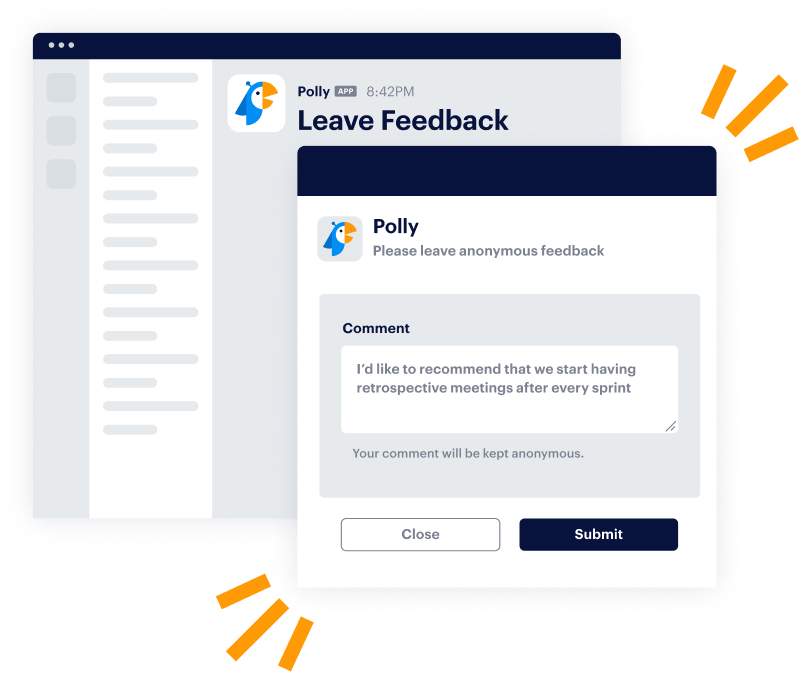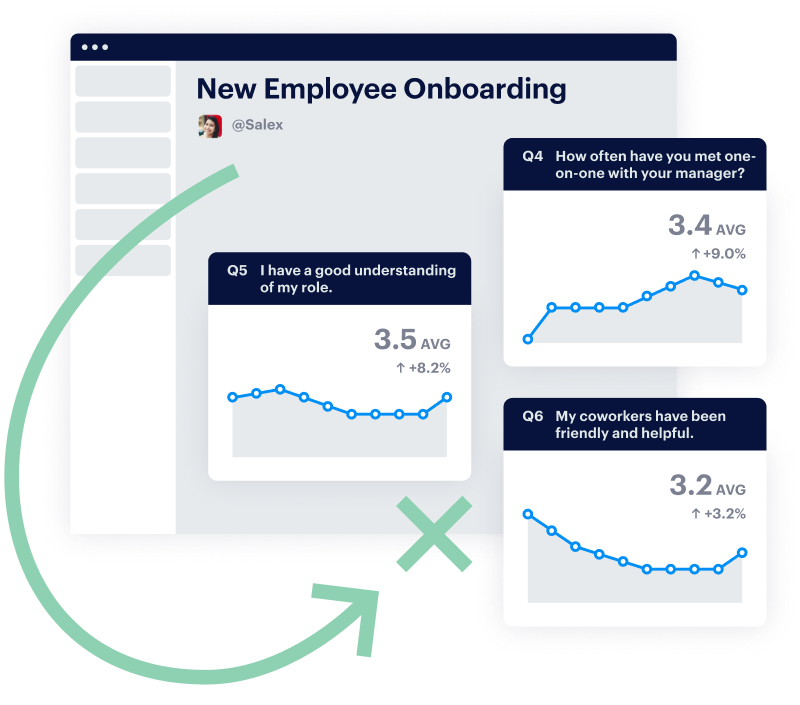Onboarding is your chance to make a stellar first impression on your new hires, but too often we don’t take full advantage of it. Most onboarding experiences range from average to terrible, and the trouble is many of us don’t even realize it — unless we invest in onboarding surveys to get feedback from new hires so we can improve the experience.
Onboarding surveys are your shortcut to not only creating a better first impression, but improving the employee experience overall.
In this guide we’ll cover:
- What an onboarding survey is
- Why you should use onboarding surveys
- How to run better onboarding surveys
It’s time to revamp the way you do onboarding for the better. Read on to discover how to make the most of this crucial moment in your new hire’s journey.
What is an onboarding survey?
An onboarding survey is like a typical feedback survey, except it’s designed to get thoughts, comments, and suggestions from your new hires as part of their onboarding experience. You might ask how the process was, what worked and what didn’t, and how you could improve it for the future.
Companies usually survey new employees after they’ve completed their formal onboarding process steps or shortly after they’ve settled in to find out how the experience was. It’s one of your first opportunities to survey your new hires and not only gather their thoughts, but to introduce them to your culture and approach to feedback.
Why having an onboarding survey makes sense
Onboarding is when your new team members will get to know your company, how you work, and what their role involves. It’s their introduction to their new world, and it’s a key moment to make a good impression. Asking your new hires for their feedback with an onboarding survey allows you to measure your impact — and more.
Investing in your onboarding process by running surveys can help you:
- 👋 Get to know your new hires and understand their needs better
- 👏 Improve employee engagement right from the start
- 👍 Find ways to improve your process and help people settle better into their new jobs
- 📣 Provide opportunities for new hires to give feedback and raise concerns
- 💼 Reduce employee turnover and increase employee retention rates
- 🔭 Get a clear understanding of your onboarding process from a new hire’s point of view
- 💚 Create a more rewarding employee experience from the first day
- 😀 Increase employee morale and happiness ratings
- 💹 Find opportunities to improve your recruitment process and onboarding workflow
Without an onboarding survey, it’s almost impossible to truly know what the experience is like as a new team member. With one, you have valuable insights that help you shape your onboarding workflow and create a better first impression for your new hires.
How to run better onboarding surveys
Simply adding onboarding surveys into your process isn’t enough. To really get the most from your data, you need to know how to use these surveys to their full advantage.
Here’s how to improve your onboarding survey process to get the best possible results.
1. Review existing onboarding feedback
If you’ve already collected feedback about your onboarding process, now is the ideal time to review it. Sit down and reflect on what previous new employees have said about your approach to onboarding, and whether you’ve made any improvements since.
Look back through old employee feedback questionnaires for any insights into your onboarding workflow, new hire journey, and hiring process. You’ll often find ideas, comments, and criticisms that can help you kickstart your process towards a better onboarding experience.
2. Decide when and how often to survey your new hires
Many companies decide to run an onboarding survey after the first month, as a way to gather first impressions and thoughts. While this allows you to collect data, it can feel quite hands-off and like a checkbox exercise. Instead, look to check in with new employees more regularly in small ways.
Use Polly to help you stay in touch throughout the orientation process with an automated check-in on the first day, and scheduled prompts like our new employee follow up and remote insights pulse survey. These short yet effective employee engagement surveys allow you to get an idea of how their first day, first week, and first month have gone.
3. Choose the right employee onboarding survey questions
 The information you collect is only as good as the questions you ask, so it’s time to start asking the right questions. Consider what you truly want to find out about your onboarding experience, and shape your questions so you get the insights you need.
The information you collect is only as good as the questions you ask, so it’s time to start asking the right questions. Consider what you truly want to find out about your onboarding experience, and shape your questions so you get the insights you need.
Popular employee onboarding survey questions include:
- How does your experience match up to your job description?
- How can we support you along your desired career path?
- What did you enjoy most about the onboarding process?
- What was missing from the experience?
- Do you feel prepared to step into your new role?
We’ve shared more of our go-to onboarding questions in our guide to new employee survey questions, so head there if you’re looking for more question inspiration.
4. Make your onboarding survey more engaging
Filling in surveys isn’t the most exciting task, even if you’re happy to take part. Give your team members the best chance of making it all the way through your survey by making it more engaging.
Use a mix of question types including rating and ranking questions, closed questions, and open-ended questions. Use smiley faces or emojis in place of number scales, and sprinkle in some of your culture throughout the survey. Keep the survey short too — it’s better to check in regularly with smaller surveys or polls than to overwhelm your new hires.
5. Allow anonymous responses
 Employees feel more able to share their honest feedback if their comments and criticisms are anonymous. That’s why your onboarding survey should be either totally anonymous, or give respondents the option to be.
Employees feel more able to share their honest feedback if their comments and criticisms are anonymous. That’s why your onboarding survey should be either totally anonymous, or give respondents the option to be.
It can be harder to encourage new hires to fill in an anonymous survey if they’re the only one joining your company. They might be concerned that their responses aren’t all that anonymous. In moments like this, let them know you’ll review their feedback together with their coworkers’ when you’ve reached a certain number. Remind them also that they can share anonymous feedback in other ways in the meantime — like your Open Forum, if you already use (or are about to sign up for) Polly.
6. Commit to a culture of feedback
When someone new joins your team, they’re not sure what your company culture is like. They don’t know whether you review feedback and act on it, or simply collect responses and never look at them. Now is the perfect opportunity to introduce them to your culture of feedback and say welcome to the team.
Your new team members and their coworkers are more likely to fill in employee engagement or employee satisfaction surveys if they know they’re meaningful. Show that you care about continuous improvement and share updates on new initiatives, changes you’re going to make, and ideas you’ve acted on as a result of your feedback initiatives.
7. Use a tool like Polly to improve the onboarding experience
 We’ve touched on it already, but one of the best ways to improve your onboarding process is to build a relationship with your new hire. Check in on them often, reassure them, and make them feel seen and heard. All of this is made easier with the help of Polly.
We’ve touched on it already, but one of the best ways to improve your onboarding process is to build a relationship with your new hire. Check in on them often, reassure them, and make them feel seen and heard. All of this is made easier with the help of Polly.
With Polly, you can revamp your onboarding program and make it more engaging and supportive. Create automated workflows that welcome your new hire on their first day, prompt them to complete orientation tasks. Use our onboarding workflows to automatically check in with new hires after the first week, first 30 days, and first 90 days — all through Slack.
Polly isn’t just a survey tool — it’s an employee engagement app with everything you need to create a welcoming experience and a system of continuous feedback.
Make onboarding new employees a more rewarding experience with Polly
So many companies set up an onboarding program and never check to see whether it’s actually working. With an onboarding survey, you can get useful insights into what your new hires experience and how to improve it for the future.
Use this guide to help you put together an onboarding process that not only introduces new employees to your company and their role, but welcomes them to your team and your feedback culture. Put employee feedback front and center, so they know you’re serious about constant improvement and creating better employee experiences. Make all this happen with Polly’s employee onboarding workflow and transform your onboarding experience for the better.

Written by Nicola Scoon
Nicola Scoon is a freelance writer that's passionate about employee engagement and better workplace experiences. She draws on her experience in internal communications to help companies create content that empowers, encourages, and motivates people to create better experiences for all.







